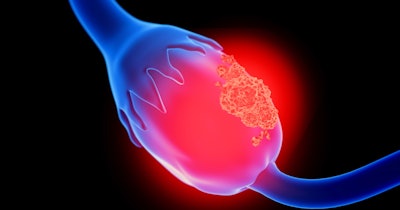
Nanopore sensors that use gold nanoparticles to capture certain peptides could enable the detection of ovarian cancer biomarkers in urine samples, according to a paper published in ACS Sensors.
Healthcare providers currently lack a way to reliably screen for ovarian cancer and sometimes need to perform surgery to confirm a tumor is present. Five-year relative survival rates range from 93% to 97% if the cancer is found while it is localized to the ovary, depending on the type of tumor, but many diagnoses are only made after symptoms have begun and the malignant cells have spread to other sites.
Early detection could mean more patients get diagnosed when the cancer is localized or regional, rather than when it is distant. For invasive epithelial ovarian cancer, the five-year survival rates for those three states are 93%, 75%, and 31%, respectively.
Researchers have identified urine biomarkers associated with ovarian cancer but have lacked accurate, low-cost, and robust sensors for detecting the molecules. Mass spectrometry, the gold standard in terms of accuracy, is not readily available for clinical applications.
The ACS Sensors paper describes work to improve the detection of peptides in urine. Earlier projects showed that nanopore sensing can enable low-cost, high-throughput detection but is challenged by issues such as the large number of peptides present in many samples. Researchers at Virginia Commonwealth University have identified gold nanoparticles as a way to overcome the issues.
Gold nanoparticles enable the selective detection of peptides that contain cysteine, the least abundant amino acid in the proteome. Because cysteine accounts for 2% of all amino acids, the nanoparticles may reduce the complexity of samples by capturing a small proportion of the peptides they contain.
The scientists encountered problems when trying to detect low-molecular-weight peptides, but had more success identifying larger molecules. Detection and differentiation of two cysteine-containing peptides from the LRG-1 protein found in the urine of ovarian cancer patients point to the clinical potential of the approach. The researchers generated proof-of-concept data by adding an LRG-1 peptide to female urine.
While the urine test provided proof of concept, it also showed the work that needs to be done to get the approach ready for clinical use. The sensor detected the peptide at 250 μM, a concentration that exceeds the 2-nM level seen in the urine of ovarian cancer patients. The researchers said that “a more advanced protocol,” likely featuring concentrating steps, will be needed to detect the peptide at 2 nM.



















